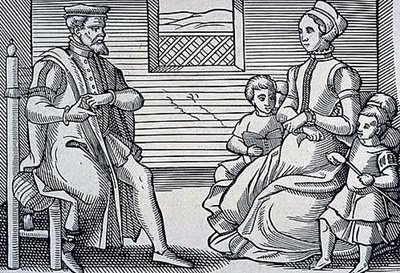 |
| Puritans and Puritanism |
In the 16th and 17th centuries, English Puritans were Calvinists in theological allegiance. They believed in the supreme authority of God and the evangelical truth of the Bible, emphasized the predestinated salvation of the elect by God’s grace alone, strove to rehabilitate depraved human souls by living a saintly life out of gratitude of God’s grace, and preferred organizing of electoral and congregational communities according to the providence of God to earthly authority. The Puritans shared a strong antipapal and anti-Catholic sentiment but disagreed as to how to construct a heavenly kingdom on earth.
The English Puritans distinguished themselves from other Protestants of the same period by their absolute conviction that all human beliefs, institutions, and actions ought to be rigorously verified by the literal meaning and syllogism of the Bible.
The complicated interactions among the Puritans, the Anglicans, and the Catholics had significant impact upon the direction of the Church of England and the emerging modern English nation during the Tudor and Stuart periods.
  |
Queen Elizabeth's Role
At the beginning of Queen Elizabeth I’s reign (1558–1603), the exiled English Protestants, victims of the Marian restoration of Roman Catholicism, returned from the Continent, where they had experienced a “purer” Christian worship than that was prescribed in the Book of Common Prayer sanctioned by the English parliament of 1552.
Some of their leaders believed that the Elizabethan Church of England retained “impure” Catholic elements in its liturgical formation. A minority of radical Puritan clergy also wanted to replace the Anglican episcopacy with the Calvinist congregational structure and presented their demands in the Admonitions to Parliament in 1572.
The document never reached the floor of Parliament because it displeased the queen. Nevertheless, Puritan Nonconformists, those who refused to use the Book of Common Prayer in their congregations, began to emerge.
The Puritans, in general, did not threaten the queen’s regime; neither did they openly break with James I (r. 1603–28) at the beginning of his reign. In the Hampton Court Conference of 1604, the king authorized the production of the King James Version of the Bible, which pleased all Protestants, including the Puritans.
Nevertheless, the king vehemently defended his divine right and refused to make any concession to the Puritan Nonconformist demands; some Puritans grew discouraged about their reform efforts and began to separate themselves from the Church of England.
Those separatists would soon migrate to the New England colonies. There, they established their Congregationalist churches and spread their beliefs, work ethics, and way of life. In the next two centuries, American Puritanism significantly impacted American political and social structures.
In England, the Puritans became revolutionaries under Charles I (r. 1628–49), when the fear of Catholic restoration, complicated by other social, political, and religious factors, pushed England into civil war (1642–60).
Between 1643 and 1647, many Puritan teachings and rituals were incorporated into the Westminster Confession and Catechisms sanctioned by the Long Parliament, which enhanced the Puritan influence against the Stuart king, but they were strongly opposed to the ideas of the church-state relationship embodied in those documents.
After the parliamentary New Model Army, composed mostly of the Puritan volunteers, defeated and executed the king in 1649, Oliver Cromwell, the Puritan general and Lord Protector, experimented with a Puritan-styled Commonwealth during the Interregnum (1649–60). Cromwell’s moderate and tolerant policies were disrupted by fellow Puritan radicals: the diggers, the levellers, and the officers and soldiers who followed the apocalyptic prophecy of the fifth monarchists.
Stuart Restoration
During the Stuart Restoration (1660–88), Charles II (r. 1660–85) reestablished royal authority and the Church of England. From 1661 to 1665, Parliament passed a set of laws to restrict the nonconformist Puritans and Catholics, known as the Clarendon Code.
The code required the Puritans to conform to the Anglican Church and its supreme governor, the king, and to use the Book of Common Prayer in public worship. It also prohibited their gatherings of more than five persons and their being within five miles of a city.
In 1672, the Test Act excluded about 2,000 nonconformist Puritans from holding public office. These prejudicial and persecutory policies became moderated in the Glorious Revolution (1688–89), when the Puritans began to be able to live under the laws prescribed by the Act of Toleration in 1689. Some of the discriminating mechanisms against the Puritans remained effective in different legal forms until the early 19th century.
After the Glorious Revolution, the English Puritans gradually faded away from the center of English parliamentary politics, which began to be dominated by two contentious parties, the Tories and the Whigs. In the American colonies, the Puritan movements declined after the American Revolution.